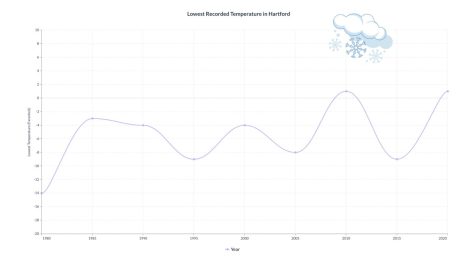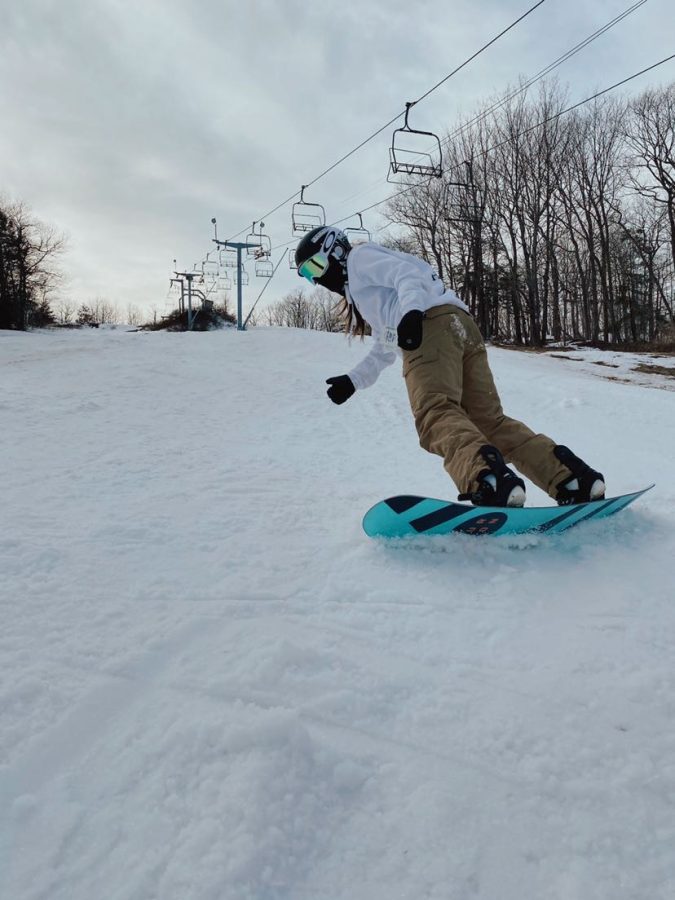Warming Winters
The Effects of Climate Change on Winter Weather
As the winter months arrive, many notice a change in weather compared to previous winters. Not only are we experiencing warmer temperatures throughout winter, but also “weather whiplash”, or rapid weather shifts. These changes can be linked to climate change.
Climate change is caused by the increase in greenhouse gasses, such as carbon dioxide and methane, being released into the atmosphere. These gasses trap the sun’s heat in the atmosphere, increasing the atmospheric temperature. This has led to increased temperatures throughout the winter months.
When looking at the lowest recorded temperatures in Hartford, CT each year, a rise in temperature can be seen. According to Current Results, Connecticut used to see much colder weather. Throughout the 80s the temperature would drop as low as -21 degrees Fahrenheit, much lower than last year, with the temperature only reaching -1 degrees Fahrenheit and -7 the year before that.
Although we are only weeks into 2022, cases of weather whiplash have already occurred. Only two days into January, extremely warm temperatures were recorded, reaching mid-50s. Temperatures this high in January are very uncommon, as most other days this January saw temperatures in the high 20s to mid-30s. Although temperature changes are common, these changes have become more dramatic due to climate change.
Climate change has not only affected temperatures but has also affected those who participate in winter sports, such as outdoor hockey, skiing, and snowboarding. Many of these sports are experiencing changes in their season length and how they practice.

Riley Grunow, a junior at Foran High School, who enjoys skiing throughout the winter months says, “Winters where there was lots of snow allowed me to be able to go skiing more and closer to home, rather than traveling to Vermont to ski.” Skiing resorts rely on cold weather for their customers and revenue. With warmer temperatures and less snow, these resorts end up having to make their snow.
It can cost thousands of dollars to cover just one acre of land with snow. ESPN reports that it can cost between $500,000 and $3.5 million for a resort to produce snow for the season. The increasing need for man-made snow has taken a toll on the ski industry adding additional costs to resort expenses.
“Colder weather and more snow allow me to ski longer, sometimes even into early March,” Grunow continues.
Climate change can affect the length of sports seasons, colder weather allows for winter athletes to practice earlier in the year, and to practice later in the year. Grunow has experienced a shorter ski season in the past due to warmer weather and hopes for a change in the future.
Although climate change has been around for decades, there is still time to prevent further development and worsening of the issue. The change in weather and challenges presented towards winter weather and sports have affected a vast amount of the population, but all can do their part to prevent the change and protect our planet.
Your donation will support the student journalists of Foran High School. Your contribution will allow us to purchase equipment and cover our annual website hosting costs.

Hi, my name is Ginger Schmidt and I am a senior. This is my second year writing for the Mane Street Mirror. I am the captain of my school's gymnastics...

HI! My name is Julia DeEll and I am a senior here at Foran Highschool. During the fall and winter I participate in cheerleading then in the spring I enjoy...







